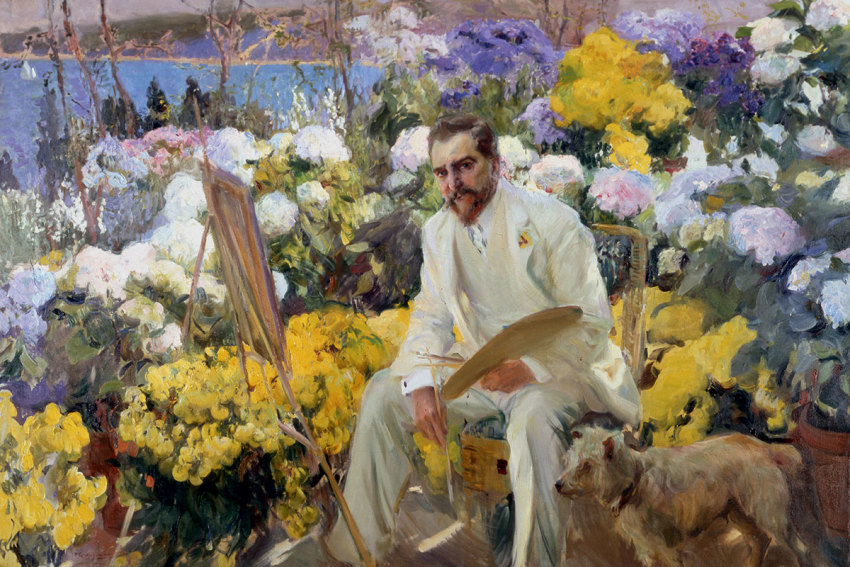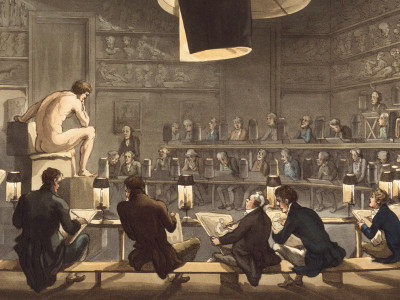
Natural affinity: six gardeners pick their favourite painters
By Tim Richardson
Published on 8 February 2016
Garden historian Tim Richardson explores the relationship between artists and garden-makers, and selects six of the world’s most celebrated garden designers to shed new light on the artists in Painting the Modern Garden.
From the Winter 2016 issue of RA Magazine, issued quarterly to Friends of the RA.
The relationship between gardens and the art world has become somewhat fraught in recent years, chiefly because gardens mean wildly different things to different people. The garden is caught somewhere between two extremes. It can be the weekend and evening hobby promoted on television by Alan Titchmarsh, where the garden is seen as a place for growing flowers, fruit and vegetables, perhaps with the idea of the garden as a "leisure space" tacked on to that, with decks, barbecues and so on. At the other extreme there is the garden as a place for meaningful expression: the symbolic temples, vistas and glades of the 18th century, or in our own time the poetically nuanced creation of Ian Hamilton Finlay at Little Sparta in Scotland, Derek Jarman’s mystical seaside garden in Dungeness, or the drama of Charles Jencks’s cosmological landscapes.
The impression one has is that some people – especially those from fine art backgrounds – would like to keep gardens in their place, in the first category, as an amateur’s hobby. As a result, those who seek a deeper intellectual and artistic engagement with gardens can be frustrated by the condescension they experience – imagined or not – coming from an "artistic establishment" that mistrusts a genre in which mutability is key, and where the artist can only exert a certain amount of control over the finished product. Garden-makers revel in this lack of control, while artists might look on aghast.
When treating the garden as subject matter, some contemporary artists plump for a satirical take on the notion of the garden as a kind of 1950s suburban, middle-class throwback: pipe-chomping males mowing the lawn while wives in pinafores bake indoors. As satire, this amounts to dull cliché, so it is always refreshing to come across artists who engage with the idea of the garden on a deeper level. To gardeners, it is obvious when an artist demonstrates an affinity with plants. There will be a vibrant, unpredicatable and palpably living aspect to the depiction, which is clearly the result of a sympathy with the subject – plants and gardens are portrayed as dynamic living entities that affect the world.
There are many and various examples of just this kind of affinity in the RA's exhibition Painting the Modern Garden. Monet was pre-eminent as the painter who understood the ways of plants – not surprising, as he was a keen horticulturist – while Sargent and Matisse were intimate with them in different ways. Artists such as Pissarro, Sorolla and Bonnard were drawn more to a sense of place in gardens.
Cézanne painted space itself, while for Kandinsky and Dufy (The Little Palm Tree, 1905; pictured) it was the excitement of shape, form and texture that was the stimulus. Munch and Vuillard used the garden as a metaphorical visual cipher. Klee deconstructed it to create mythic analogies. Van Gogh, as ever, was painting something else altogether.
For garden designers and landscape architects, paintings of gardens and landscapes can be curious and compelling, as demonstrated by the accounts on these pages, in which six designers revel in the mystery and ambiguity of garden art. For those working creatively in the world of gardens, it is not botanical accuracy that is of prime interest but the way in which an artist can capture an intriguing or mysterious moment in a garden setting. It seems that a painting can draw in the viewer just as a garden does. Perhaps we might think of ourselves as "visitors" to garden paintings, as opposed to mere "viewers" – it is as if we become absorbed, in some way, in the depiction of garden space.

Tom Stuart-Smith on Camille Pissarro's Kitchen Gardens at L’Hermitage, Pontoise (1874)
Multiple winner of "Best Show Garden" at Chelsea Flower Show, Stuart-Smith creates naturalistic gardens, including the garden at the RA’s Keeper’s House.
It is the blinding white light of early spring that is initially so arresting about this painting by Camille Pissarro of a vegetable garden in what is now virtually a suburb of Paris. It is one of those savagely bright March days before bud-burst, when the ice-blue foliage of leeks seems almost made of steel.
What draws one in further is the direct and unaffected depiction of menial and practical domestic cultivation. The spindly trees on the left of the picture have been shredded in the traditional French manner that can still be seen in Brittany, where the young wood is cut for kindling or even animal feed. Nothing is here for show; it is all entirely practical and productive. The scene has an honest beauty for us and presumably for Pissarro, too. We know from the date of the picture that the railway that connects Pontoise to the city had just been built and that this self-sufficient peasant life was soon to be swallowed up by a greater commercial imperative. It was a way of life that was about to disappear.
The painting presents an interesting counterpart to Monet’s Lady in the Garden (1867), where an elegant young woman with a parasol stands non-plussed in front of an absurd mass of scarlet geraniums plonked onto an immaculate lawn. It seems that alienation from nature is the inevitable fate of the elegant bourgeoisie, whereas perhaps if we keep Pissarro’s dirt under our fingernails there is still hope that we can connect with the natural world.
I can’t say that I have ever taken a painting as a direct springboard for a creative idea. The effect is more diffuse than that, and a sculptural work or some music might also creep into the thought process. The translation is never direct or literal, however. I prefer to keep references and metaphors quite well buried in my work.
I always make drawings of the gardens that I am designing. There is a fascination for me about drawing something that doesn’t yet exist, like making a short fiction about a place, trying to say more about how it might feel and be experienced, as opposed to how it will look.
Fergus Garrett on Joaquin Sorolla's Louis Comfort Tiffany (1911)
As Chief Executive and Head Gardener at Great Dixter in Sussex, Garrett presides over a garden which connoisseurs of horticulture consider to be a benchmark internationally.
This portrait, with the subject sitting in his Long Island garden by an easel with brush in hand, surrounded by lavish blooms, struck a particular chord with me. It has an other-worldly opulence, the backdrop to the sitter dripping with flowers in whites, yellows and blues, the bright blue sea in the distance, visible through naked tree-trunks and the tops of conifers.
The artist is immaculately dressed in a white suit and is posing, rather nonchalantly, with his dog by his side, as if he has just been surprised by the artist. The sumptuousness of the flowers contrasts with the casual pose of an indifferent-looking Tiffany. Sorolla has captured an air of confidence in the sitter, with a kind of electricity coming from the large flowers that surround him. I can see a similar effect at Dixter, where the personalities of our gardeners often seem to be complemented by the vegetation around them.
There are no inhibitions in this painting, no holding back, except perhaps when it comes to the figure that sits in the centre. He appears on one hand confident and relaxed, but at the same time he is also reserved, bashful and reticent – a familiar contradiction in so many of us.
For me gardens are about people, and the most intriguing gardeners are those quiet, sometimes withdrawn characters who have a meaningful creativity burning inside them. This is expressed only when they are at home, and comfortable, in their gardens, with flowers representing their voice and imagination.
My own thoughts are expressed through flower combinations and the experiments conducted with plants, and all the time my character is exposed by the idiosyncrasies within the garden. Every moment when I am within its borders I feel as if I am inside a painting, in a scene such as Tiffany’s garden in Long Island perhaps. It feels larger than life, bigger and more meaningful than simply the individual flowers with which I am working.
For some of us, gardens are as thought- provoking as paintings, where a gardener’s eye can be as acute as the artist’s. I am not suggesting that this is what Sorolla is trying to express in this painting, but this image certainly stirred those emotions in me.

Arabella Lennox-Boyd on August Macke's Garden Path (1912)
One of the most respected garden designers working in Britain today, Lennox-Boyd counts the Duke of Westminster and the Rothschild family among her many clients.
I was first drawn to this picture because of the path that leads us forward mysteriously to an area that cannot be seen. Such an atmosphere is essential in any garden, for it must always contain a series of surprises, as well as extravagance, with visual and sensual experiences. A garden is like a dream and should combine the excitement of the unexpected with vivid sensations.
As I look further into the painting, I am enchanted by its dramatic use of colour. The pink path looks perfectly normal, though I have never in my life seen one of such a colour. The pink contrasts so dramatically with the pale green, which itself emphasises the darker greens in the border. The lawn to the right also leads the eye forward into the unknown. Clearly the border is richly planted, with exotic leaves and dashes of colour creating an exuberant me?lange of shapes.
The composition is dominated by the curve of the path, which is balanced by the forms of upright flowers, twisted foliage and five dramatic blobs of colour belonging to flowers whose names are unknown. There is a mixture of secrecy, formality and looseness here – something that I always try to introduce in my own work.
This is a beautiful painting in its own right, but I believe that walking down the path in the actual garden would provide a multitude of experiences of sight and smell which one cannot appreciate from the painting alone, nor indeed from any painting of any garden.
Piet Oudolf on Edouard Vuillard's Woman Seated in an Armchair (1898)
One of the world’s most celebrated plantsmen, Oudolf works on international commissions – such as the High Line in New York – from his base in the Netherlands. He recently created a garden for the Hauser & Wirth gallery in Bruton, Somerset.
It was really the colours that first attracted me to this painting. The quality of light works so well; it is not dreary or too soft. I was also drawn in by the composition, all these people in a landscape. It looked chaotic. I couldn’t really work out what kind of gathering it was.
This place doesn’t look like a park, so why were there so many people there? Or was it set at a country house? I thought it could be the day after a big party. The figure on the right behind the woman in the armchair – I wasn’t even sure if it was a statue or a person. The figure in the middle appears to be reading a newspaper. Were they all waiting for something? It is a strange scene. In fact, this scene looked to me like something that never happened.
It was later that I learned that Vuillard painted this scene in the garden of his friends, Thade?e and Misia Natanson. Misia, muse to the Nabis painters, is the woman in white who sits in the chair. The artist Pierre Bonnard is the man reading the newspaper.
In the exhibition Painting the Modern Garden, all of the paintings seem to be inward-looking; they show nothing outside the garden. This is usually the case with paintings of gardens – they are a metaphor for beauty or paradise.
When I look at a painting it brings up a feeling in me, and sometimes when I am subsequently working on a design, everything that was good about that feeling bubbles up inside me. I always trust myself at this point – it’s as if I have recognised something that I hadn’t noticed before. The memory of the painting can define or help to clarify ideas. This energy can go from a painting to a garden and vice versa.

Kathryn Gustafson on Edouard Manet's Young Woman Among the Flowers (1879)
With offices in London and Seattle, Gustafson pursues a high-profile international career, which has included the redesign of the Mall in Washington DC and the Diana, Princess of Wales Memorial Fountain in Kensington Gardens.
What is it about Edouard Manet’s paintings that always draws me in? His work might be hung in a room together with paintings by other renowned artists, but it always jumps out at me with singular clarity. Often I do not know the painting, but when I see the title and the artist’s name, I just smile. "Yes, of course it is Manet." I would have loved to have known the artist, and to have heard his words about perception and about light.
Manet paints a world that always seems to be slightly set apart. It is from the culture of the time, yes, but there is also a sense of the singularity of each moment that he depicts. I feel that he paints a heightened attentiveness. Manet’s work makes me think of being outdoors, where the fresh air makes me feel alert, aware and alive.
In this painting (below) I feel that the moment he has captured is in late May or early June, when nature is at the height of its exuberance. The young woman has walked into that natural world which envelops all your senses. It’s as if she feels that she is alone and is experiencing a movement of discovery, enjoying this amazing world of living textures, colours and smells. This painting makes me wonder whether the feelings it inspires occur in any particular order. What comes first? The feeling, the place, the emotion, the painting or the garden? I know not. I just hope to make a garden or a landscape that has the same kind of power to envelop those who come into it. I think I will always look to Manet for guidance.

Sarah Price on Henri Matisse's Acanthus (Moroccan Landscape) (1912)
Trained as an artist, Price built her reputation in garden design through the 2000s, creating delicately detailed private spaces, as well as large-scale public works, such as her plantings for London’s Olympic Park.
This painting is one of three Matisse made of a garden in Tangier in Morocco. It is on view in Stockholm’s Moderna Museet, while a later Matisse, The Rose Marble Table (1917), is coming to the RA,
Violets and purples are unusual colours to see in a garden painting, but where I live in South Wales you do see these colours at sunset. At that time of day you can look at a garden and see it in a purely visual, sensual way. You can step back. It feels as if this painting is caught in a strange twilight moment. You can just enjoy being propelled into that moment. It is one moment and it’s joyful – and that is why I make gardens.
There is ambiguity here. It’s like a garden creeping into a landscape – we’re not sure. The composition appears spontaneous and chaotic, but it’s not. It is tightly conceived, with a delicate balance of forms. It feels harmonious and alive, full of spirit. I love the way my eye bounces away from the void in the middle and moves around the painting. By using a strong magenta for the tree trunk Matisse is exaggerating the plant forms, like the whippy, multi-stemmed tree in front. In this picture it is as if each plant and tree has its own spirit, its own personality.
I like the sense of the yellow being scraped out and the dappled light coming in. And the peachy colour in the top right against the lilac and the acid yellow. It picks up on some autumn colours. I can almost sense the heat coming off the bush.
What initially drew me to the picture were the colours, and then the use of negative space. I thought, "This is what I am aiming at when I am composing my garden spaces." There is so much negative space around the plant forms. They really hold their own.

Painting the Modern Garden is in the Main Galleries of Burlington House from 30 January until 20 April 2016.

Enjoyed this article?
"As well as free entry to all of our exhibitions, Friends of the RA enjoy one of Britain’s most respected art magazines, delivered directly to your door. Why not join the club? "
Related articles

Visions from Ukraine
19 June 2024

10 RA Schools stories through the centuries
16 May 2024

In memoriam: Mick Moon RA
1 May 2024